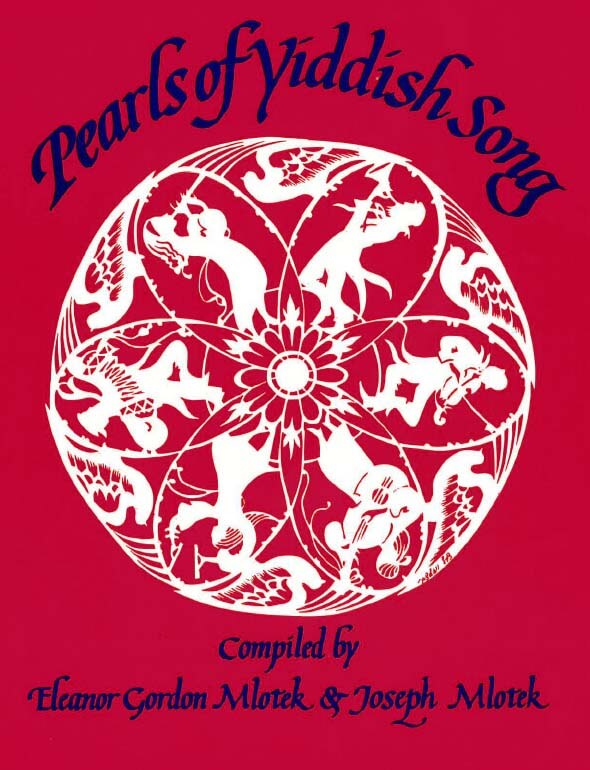Folksong published by Y. L. Cahan in 1912 and by M. Kipnis in 1918. The song was in the repertoire of the famous folksong interpreter Isa Kremer.

I lay my little head
on my mother’s little bed;
My mother walks by
and she beams and beams:
“Sleep my little daughter, my heart,
you have dark little eyes,
sleep in good health, sleep in good health!”
I lay my little head
on my father’s little bed;
My father walks by
and he beams and beams:
“Sleep my fine little daughter,
you have dear little eyes
sleep in good health, sleep in good health!”
I lay my little head
on my mother-in-law’s little bed;
My mother-in-law walks by
and she stands and stands there:
“My daughter-in-law is no great housewife,
she doesn’t lift a finger!
She just sleeps and sleeps,
she just snoozes and snoozes.
I lay my little head
on my husband’s little bed,
My husband walks by
and he beams and beams:
“Sleep, my dear little wife,
you have such pretty little teeth,
sleep in good health, sleep in good health!”
Leyg ikh mir mayn kepele
Oyf mayn mames betele;
Geyt mayn mame farbay,
Nokh anand zi tut un kvelt:
— Shlof, mayn tekhterl hartsinke,
Eygelekh hostu shvartsinke,
Shlof gezunterheyt! shlof gezunterheyt!
Leyg ikh mir mayn kepele
Oyf mayn tatns betele;
Geyt mayn tate farbay,
Nokh anand er tut un kvelt:
— Shlof, mayn tekhterl fayninke,
Eygelekh hostu kleyninke,
Shlof gezunterheyt! shlof gezunterheyt!
Leyg ikh mir mayn kepele
Oyf mayn shvigers betele;
Geyt mayn shviger farbay,
Nokh anand zi tut un shelt:
— Mayn shnur iz keyn berye nit,
Keyn melokhe tut zi nit!
Nokh anand zi tut un shloft,
Nokh anand zi tut un poft.
Leyg ikh mir mayn kepele
Oyf mayn mans betele,
Geyt mayn man farbay,
Nokh anand er tut un kvelt:
— Shlof, mayn vaybele kleynlnke,
Tseyndelekh hostu sheynlnke,
Shlof gezunterheytl shlof gezunterheytl
לײג איך מיר מײַן קעפּעלע
אױף מײַן מאַמעס בעטעלע,
גײט מײַן מאַמע פֿאַרבײַ,
נאָך אַנאַנד זי טוט און קװעלט:
— שלאָף, מײַן טעכטערל האַרצינקע,
אײגעלעך האָסטו שװאַרצינקע,
שלאָף געזונטערהײט! שלאָף געזונטערהײט!
לײג איך מיר מײַן קעפּעלע
אױף מײַן טאַטנס בעטעלע,
גײט מײַן טאַטע פֿאַרבײַ,
נאָך אַנאַנד ער טוט און קװעלט:
— שלאָף, מײַן טעכטערל פֿײַנינקע,
אײגעלעך האָסטו קלײנינקע,
שלאָף געזונטערהײט! שלאָף געזונטערהײט!
לײג איך מיר מײַן קעפּעלע
אױף מײַן שװיגערס בעטעלע,
גײט מײַן שװיגער פֿאַרבײַ,
נאָך אַנאַנד זי טוט און שעלט:
— מײַן שנור איז קײן בריה ניט!
קײן מלאָכה טוט זי ניט!
נאָך אַנאַנד זי טוט און שלאָפֿט,
נאָך אַנאַנד זי טוט אַ פּאָפֿט.
לײג איך מיר מײַן קעפּעלע
אױף מײַן מאַנס בעטעלע,
גײט מײַן מאַן פֿאַרבײַ,
נאָך אַנאַנד ער טוט און קװעלט:
— שלאָף, מײַן װײַבעלע קלײנינקע
צײנדעלעך האָסטו שײנינקע,
שלאָף געזונטערהײט! שלאָף געזונטערהײט!
Song Title: Leyg Ikh Mir Mayn Kepele

First published in 1988 as Pearls of Yiddish Song: Favorite Folk, Art and Theatre Songs, this anthology contains 115 songs. Some material had never been published, while others, included in rare song collections or sheet music, were largely inaccessible. The songs presented reflect Jewish life in Eastern Europe and the United States and depict childhood, love, family celebrations, poverty, work and struggle. There are also songs from the Hasidic and Maskilic movements, songs of Zion and of America, as well as songs from the Yiddish theater.
The title of this anthology derives from the weekly two-page feature column “Pearls of Yiddish Poetry,” which the compilers Yosl and Chana Mlotek initiated in 1970 in the Yiddish newspaper Der Forvertz (the Yiddish Daily Forward). Hundreds of readers from around the world — including authors, composers, singers, actors — became co-participants in this collective folk project and recalled melodies, lines, fragments, stanzas and their variants of songs, poems, and plays which they had heard in their youth. At first, readers sent in only written material. Later, they also taped songs on cassettes, many of whose melodies had, until then, never been recorded. They also identified and supplied missing information regarding lyricists, poets, and composers and described the circumstances surrounding the songs’ origins, their dissemination, diffusion and impact.